 |

- In 1918 Umekichi Yoneyama(1868-1946), President of Mitsui Trust Company, visited the US as a member of a Japanese financial delegation. In Dallas he was introduced to Rotary by a member of the Dallas Rotary Club, Kisaji Fukushima (1881-1946), the director of Dallas branch of Mitsui Trading Co. ltd. Yoneyama was deeply impressed with the Rotary Spirit, "Service, not self". Fukushima returned to Japan in January 1920 on a mission to organize Rotary Club in Japan, which unfortunately ended unsuccessfully. But Yoneyama and Fukushima established the Rotary Club of Tokyo (the first rotary club in Japan) successfully on October 20, 1920. A charter was granted on April 1 the following year (Charter No 855). Fukushima then moved to Osaka and the 2nd Rotary Club was organized there in November 1922. On September 1, 1923 the strong earthquake occurred in the central part of the main island of Japan and Tokyo area was severely damaged. Then US ambassador S. E. Woods immediately reported this tragedy to the US government and within 60 hours after occurrence of the Kanto earthquake the USS Destroyer appeared in Tokyo Bay to start rescue activities. It is said that Japanese Rotarians in Tokyo were so impressed with the effective and immediate action of the US navy that they decided to meet every Wednesday so that they could also start meaningful activities for others.
- Yoneyama was appointed as RI SC (Special Commissioner) and supported the Kobe Club (the 3rd Club in Japan) and the Nagoya Club (the 4th Club in Japan) to organize in December 1924. In Kyoto Tojiro Takegami, Ihei Hiro-Oka met to organize a rotary club in Kyoto under sponsorship of the Tokyo Club with other 18 people on July 22, 1925 and to select the 25 charter members on September 19th, the same year. The preparatory meeting was held on September 25th at Kyoto Hotel with attendance of Pres Isaka, the mother club, Tokyo RC, to elect the directors of Kyoto RC as
- President
- Goichi Takeda (Prof. Kyoto Imperial University)
- Vice Pres.
- Tojiro Takegami (Pres. Takegami Raw Silk Co.Ltd.)
- Secr'y
- Takeo Inouye (Prop. Kyoto Hotel)
- Tres.
- Gisuke Miyamoto
- SAA
- Kiyoshi Shiomi
- Directors
- Sobei Kinkozan, Bunzo Shitsukawa, Shotaro Shimomura, Ihei Hiro-Oka
-
The Opening Ceremony of the Kyoto Club (New President Goichi Takeda, New Secretary Takeo Inouye) was held on September 28,,
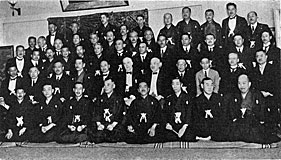 1925 with attendance of Takeshi Isaka (President, Tokyo Club), Shozo Murata (President, Osaka Club), Shigehiko Ikoma (President, Nagoya Club).The application of its charter was made to Rotary International on October 7th 1925. The Congratulatory Banquet was held on October 28th with the Special Commissioner Yoneyama and many distinguished guests including A Cooper from Hawaii. The RI charter was granted on December 24th the same year (No. 2184).Through many discussions the KRC board of directors reached to the conclusion on March 6th 1974 that KRC was founded on October 7th 1925. 1925 with attendance of Takeshi Isaka (President, Tokyo Club), Shozo Murata (President, Osaka Club), Shigehiko Ikoma (President, Nagoya Club).The application of its charter was made to Rotary International on October 7th 1925. The Congratulatory Banquet was held on October 28th with the Special Commissioner Yoneyama and many distinguished guests including A Cooper from Hawaii. The RI charter was granted on December 24th the same year (No. 2184).Through many discussions the KRC board of directors reached to the conclusion on March 6th 1974 that KRC was founded on October 7th 1925.
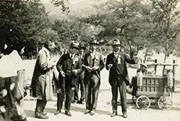 It was such a surprising event for Kyoto Club members to unexpectedly greet Prince of Wales from Britain as the Royal Guest on the weekly meeting on May 7th 1926. This news remarkably highlighted Rotary Club as an international organization for ordinary people to recognize. The First District Meeting of RID 70 was held on April 27 to 28, 1929 at the Kacho Hall of Chion-in Temple in Kyoto chaired by the Governor Umekichi Yoneyama.
It was such a surprising event for Kyoto Club members to unexpectedly greet Prince of Wales from Britain as the Royal Guest on the weekly meeting on May 7th 1926. This news remarkably highlighted Rotary Club as an international organization for ordinary people to recognize. The First District Meeting of RID 70 was held on April 27 to 28, 1929 at the Kacho Hall of Chion-in Temple in Kyoto chaired by the Governor Umekichi Yoneyama.
- In February 1935 Paul Harris, his wife Jean Harris and RI President Robert E Lee Hill made a major journey to the Pacific region. They arrived at Yokohama on "the S.S. President Coolidge". As the bad weather prevented Harris' party from landing for a couple of days, they were unable to attend the normal meeting of the local Rotary Club. But instead they went to a splendid special banquet, presided by Yoneyama. Then "the S.S. President Coolidge" cruised off to Kobe. On February 10 Paul Harris and his group took a train to Kyoto to visit the Nijo Castle and the Hekiun-so (Nomura Garden) and they moved to Osaka.to join the welcome reception hosted by three rotary clubs of Osaka, Kobe and Kyoto.
- In 1940 there were 48 clubs and nearly 2,000 Rotarians in Japan. As they took the attitudes against the coming war, the political pressure was brought on Japanese Rotary affiliated to RI Headqurarter in US by the then Government and right wingers but the ideals of the Rotary movement were kept alive. In 1937 ~ 38 a study group of national emergency (pro-nationalist group) was formed however in Kyoto Club with no record left for their activities. There appeared severe confrontation among KRC members whether KRC should continue or discontinue its activities. On August 21st 1940 the President Mochizuki declared to disband the Rotary Club of Kyoto and "Wednesday Club" was started on August 28th. On September 19th 1945, soon after Japanese surrender to the Allied Powers of World War II, the Kyoto Hotel was so requisitioned by the US Occupation Forces that the Kyoto Wednesday Club had to change its meeting location to the dining floor of the Daimaru Department Store in Kyoto.
-
Within almost a year after the World War II the two founders of Rotary Clubs in Japan passed away, U Yoneyama (April, 1946) and K Fukushima (September 1946). And Paul Harris also passed away in Chicago in January 1947. We should note a truly great Rotarian, Sir Angus Mitchell, who was the first Australian to be elected as the RI president for 1948-49. He was a very close friend of Paul Harris and is credited with the re-establishment of Rotary in Japan after the end of World War II.
In September 1948 George R Means (the RI secretary general for Asia) visited Japan and he devoted himself to make Japanese comeback to the international society. His devotion resulted in the restart of rotary activities in Kyoto. 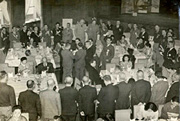 The Restarting Ceremony of Rotary Club of Kyoto was held on March 23rd 1949 where George R Means attended and the RI charter was re-granted on April 5th 1949 with the same charter number as before, (No. 2184). The rotary clubs in Japan formed then the new RID 60 and the postwar first district conference was held at the Eiko Building, Doshisha University in Kyoto on April 8th 1950 where Sir Angus Mitchel (IPRI) attended in behalf of the RI President. The Restarting Ceremony of Rotary Club of Kyoto was held on March 23rd 1949 where George R Means attended and the RI charter was re-granted on April 5th 1949 with the same charter number as before, (No. 2184). The rotary clubs in Japan formed then the new RID 60 and the postwar first district conference was held at the Eiko Building, Doshisha University in Kyoto on April 8th 1950 where Sir Angus Mitchel (IPRI) attended in behalf of the RI President.
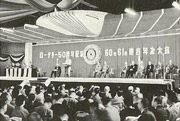 On October 16~17 1954 the 60/61 District Conference was held at Kyoto International Exhibition Hall (now Miyakomesse) to celebrate the 50th anniversary, particularly highlighten by the lecture of the Japanese first Nobel Prize laureate, Professor H Yukawa and by the message of RI President Herbert Taylor delivered by Sir Angus Mitchel.
On October 16~17 1954 the 60/61 District Conference was held at Kyoto International Exhibition Hall (now Miyakomesse) to celebrate the 50th anniversary, particularly highlighten by the lecture of the Japanese first Nobel Prize laureate, Professor H Yukawa and by the message of RI President Herbert Taylor delivered by Sir Angus Mitchel.
- Since the restart of rotary activity, members of KRC steadily increased from 50 to more than 250 for the 1950s to 1970s and remained almost constant for the 1980s and 1990s, only to decrease gradually afterward. The rise and fall of KRC was affected by the Japanese postwar economic recovery.
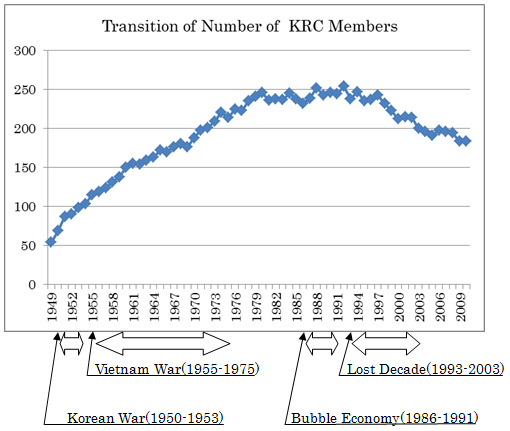
- Soon after the end of the WW II the Cold War era started. In Asia the cold war was so overheated that major military conflicts occurred in Korea (Korean War, 1950-1953), Vietnam, Laos and Cambodia (Vietnam War, 1955-1975). The Korean War brought a special procurement boom to the economic recovery for Japan. During the 1950s to 1970s Japanese economic development was so remarkable that its GDP ranked the Second in the world, surpassing West Germany in 1968. Note that the United States carried out the return of the Ryukyu Islands and the Daito Islands (Okinawa) to Japan in 1972 although there was some political social unrest: the 60 year struggle (opposition campaign for revised Security Treaty between Japan and US) for instance and campus strife at universities (1968-1973). However the Japanese postwar economic miracle was highly appreciated as expressed in the comment, “Japan is Number One” induced by an export-led economic recovery which in turn greatly inflated real estate and stock prices (bubble economy japan, 1986-1991). The bubble collapse lasted for more than a decade with stock prices bottoming out in 2003 (referred to as the Lost Decade), until hitting an even lower low amidst the current global crisis in 2008 (Shockwaves from the Lehman Brother’s collapse on September 15, 2008).
- Eleven members of Rotary Club of Kyoto served as Governors of RID which KRC belonged to, and two members, Genshitsu Sen (in 1988-90) and Ryuichi Kotani (in 1998-2000) served as RI Directors. On May 23 to 26, 2004 the RI's largest convention with 45,381 attendees was held successfully in Osaka, chaired by Dr. Genshitsu Sen, and on May 22nd the Kyoto-Day, the pre-event of RI Osaka Convention, was jointly hosted by 23 Rotary Clubs in Kyoto to present Japanese culture, art and tradition through the UNESCO World Cultural Heritage sites. On April 10, 2005 KRC hosted the RID 2650 Conference for Rotary Centennial Anniversary at the Kyoto International Conference Center. On June 19 to 22, 2005, 39,460 Rotarians celebrated the centennial in Chicago, Illinois.
- With the aim to deepen the mutual understanding and to promote world peace, KRC maintains formal Sister Club arrangements with the Rotary Club of Hanyang Seoul Korea (1971), the Rotary Club of Boston USA (1976), the Rotary Club of Bangkok Thailand (1989), the Rotary Club of Taipei Taiwan (1989) and the Rotary Club of Honolulu USA (2004) sending visitors between clubs and participating in each others’ philanthropic projects. The Rotary Club of Kyoto celebrated its 80th anniversary on October 12th, 2005 and its 85th anniversary on October 6th, 2010 at Kyoto Hotel Okura with the attendance of distinguished guests including a number of Rtns and Rtnns from our sister clubs.
- The 9.0-magnitude (Richter scale) quake on March 11 2011, the largest in Japan’s history, and the tsunami that followed it caused widespread devastation, paralyzing much of the northern coast. More than 14,000 people have been killed, 11,000 are missing, and at least 550,000 people have been forced from their homes.
- This 3.11 Japan earthquake and tsunami destroyed 12 of 13 Emergency Diesel Generators thus disabling major cooling systems of the TEPCO (the Tokyo Electric Power Company) Fukushima Daiichi nuclear power plant, causing a series of hydrogen explosions at the nuclear reactor stations, 140 miles northeast of Tokyo, and forcing the evacuation of tens of thousands to avoid leaked radioactivity. The INES crisis level (International Nuclear and Radiological Event Scale) of ongoing Fukushima plant is evaluated as the worst level "7" – the same as the nuclear accident at the Ukrainian Chernobyl plant in 1986.
- Rotary clubs and districts worldwide immediately mobilized efforts to bring urgently needed aid to victims. In response to the massive earthquake and tsunami, the Rotary Foundation has established “the Rotary Japan 2011 Disaster Recovery Fund” to support long-term recovery projects in affected areas. This Rotary Fund has raised more than US$500,000 as of March 25, 2011.
- Soon after the Japan earthquake, Rotary Club of Bangkok and Rotary Club of Taipei expressed their intention to donate funds as well. The Rotary Club of Kyoto with our two sister clubs donated ¥5,000,000 to the Rotary Fund.
- We should never forget that the deepest sympathies, heartfelt thoughts and concerns for the people of Japan are being expressed worldwide as we devote ourselves to the long and severe work to reconstruct the shattered land in the years ahead.
The Rotary Club of Kyoto
Yasaka Kawaramachi Bldg, Nakagyo-ku, Kyoto
Tel +81(0)75-231-8738 Fax +81(0)75-211-1172
office@kyotorotary.com
|
